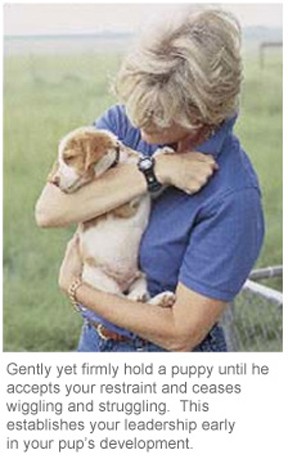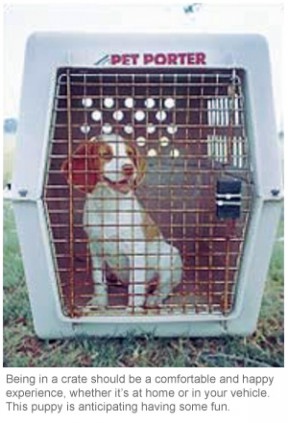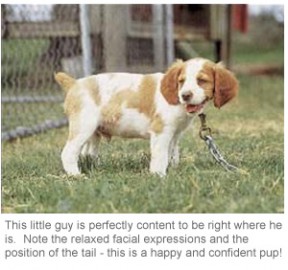



Puppyhood and Puppy Development: Immaturity vs. Capability



Whether it’s your first puppy or your tenth, the fact remains that we have a pretty good idea of what we expect him to do for us as an adult dog. Sometimes those expectations are the result of trying to replace an old dog that we’ve lost, or they may be thoughts of having a dog we admire, or perhaps we have dreams of winning in competition. Whatever the reason, we’ve unwittingly put our new puppy in the difficult position of fulfilling our dreams.
Can this puppy do all that? Assuming that we did our homework before we decided on this particular puppy, the answer is yes. Before we go any further, let’s explain what we mean by homework.
First of all, does our puppy have the right genetic material to please us? That depends on what we want. If the parents were high-powered, bug-running competition dogs and we want to compete in field trials, then yes, there’s the genetic material available for our puppy to succeed. If we want that same puppy to hunt very close on foot, we’ve probably set ourselves up for disappointment.
The reverse can be true if mamma and daddy were good, solid, close-working pleasure-hunting dogs and we expect something different from Junior. That’s not the puppy’s fault – it can only use what was bred into it. The puppy can only have the genetic potential provided y the pedigree.
The rest is left up to us, as owners, handlers, and trainers of our young protégée. When choosing a pup, have a vision in mind of what the end product will be, and keep that vision in mind throughout the dog’s training. Use it as an end goal to work toward. The important part here is to keep it a vision rather than an instant demand. Getting to that end result takes time, patience, and training. Too often, expecting three-year-old behavior at 12 weeks or 12 months ruins a good puppy.
Learning by Experience
One of the most critical mistakes made with puppies is not allowing them to learn by experience. Every experience comes with a “first time,” and there’s no way around letting them learn. Don’t deprive your dog of the consequences of its behavior!
This is the best way for our puppies to develop good thinking skills, and by overprotecting and over controlling them, we teach them to not use their brain.
It’s kind of like rearing kids: You can tell them the stove is hot, and even pull their hand away, but eventually they will touch it; and at that point, they will find out what “hot” means.
As our puppy gets older (to the “teenager stage”) at around eight to 12 months, the lessons become harder.
This of telling your teenager not to speed when driving the car. If he’s like most of us, the lesson will come in the form of a speeding ticket, and having to pay for his mistake out of his own pocket will make a valuable impression.
Again, we repeat: Do not cheat your dog of the consequences of its behavior. (Please not that there are times to ake an exception, such as running after cars or onto the road.)
While you’re allowing your puppy to learn by experience, you do have some level of control over what those experiences are and in what order they are presented to your puppy. We’ve found that doing a good job of socializing puppies and letting them explore as their world expands allows them to learn with confidence.
One extremely important experience that is often introduced way too soon is gunfire. This usually happens due to human impatience: “Let’s make sure he’s not gunshy.” If you have to see if he’s gunshy, you’ll probably be responsible for making him gunshy!
Loud noises need to be introduced carefully, and preferably combined with another distraction so the puppy doesn’t focus on the noise. Introduction a pup to gunfire should be the last thing on your list of things to do.
If you take the time to do the socialization and allow the puppy to learn, gunfire will be no big deal. On the flip side, if you rush the introduction to gunfire, you may create the very same fear you are trying to prevent. You cannot make a mistake by going too slow!
Control and Domination
Expecting mature adult behavior from an immature dog will guarantee failure. One thing we see far too often is too much control of domination on the part of the people around the puppy. When we say control and domination, we’re not talking about basic obedience. Basic obedience is what makes any dog a good citizen, both in the field and in the house.
Too mush control and domination, on the other hand, refers to telling the puppy what to do every second and trying to make it into a robot.
One of the finest qualities a good bird dog can have is the ability to think on its own. We want a dog to go and hunt for birds, and this requires a level of independent thinking. A puppy that has been controlled too much will wait for you to tell him where the birds are, and if you knew that, you wouldn’t need a dog!
When a puppy has been totally controlled, it will grow up thinking that everthing they do will be directed by a human – they will always look to that person and wait for directions.
This is great for an obedience dog but not what we’re looking for in a gun dog.
We’d rather have an independent dog that will go after a crippled bird on its own as opposed to a dog that waits for us to tell it what to do and where to go to find that wounded game. We want a trained dog that can and will think.
Fostering Leadership
The kind of control we do want with our puppies is leadership. Dogs, just like people, need and want to have structure in their lives. They want to belong to the pack. Puppies, just like people, want to look up to and follow a leader who is confident, efficient, consistent, and organized. This gives them a feeling of security.
What can we do to encourage this feeling of leadership? Puppies want to learn, and the basis for their thinking for the rest of their lives is formed during the first six months.
If a puppy thinks it can do what it wants, whenever it wants, with whatever it wants at three months of age, it will have the same thoughts as a three-year-old adult dog. Our leadership begins with making our puppy secure with our control.
The best way to start this process is by simply holding your puppy. When we pick up a puppy, we cradle it gently in our arms. Usually the pup will wiggle and squirm, and while they do, we simply continue to hold them, gently yet firmly. It’s not necessary to say or do anything else at this moment: just let the pup work it out while you hold it. Once the puppy settles down and is quiet and still, we will gently set it down. This teaches the puppy at a very early age that we are the Alpha in their pack, and they will submit to our leadership.
Another important step in asserting our leadership is teaching puppies not to jump up on us. Jumping is a form of dominant behavior, and while it may be cute at three onths and a few pounds, it’s a nuisance at three years and 80 pounds!
Our preffered way of eliminating the jumping is to tap, very gently, on the toes of the hind feet as the puppy starts to jump up. Don’t try to step hard or squash their toes; the objective is respect, not pain. After a few episodes of this, your puppy will come close to you and pause, waiting for you to reach for it, without jumping up. We start this at eight weeks, since it is much easier to prevent a bad habit than fix one later.
If we are consistently calm and steady in our behavior around our puppies, they will become secure in our leadership. If something happens that frightens them, use the same calming technique we described above. Don’t overreact of panic, since an out-of-control leader is the last thing they need at that moment.
Often, if something is new or scary, your puppy will look to you to see how you are reacting, and will take their cue from you. If you act confident, they will be confident. Even if you are nervous about something, don’t let on that you feel that way. Always act as if everything is fine. On the other hand, if you tell your pup by your actions and attitude that the world is a scary place, you will raise a spooky puppy.
The Chain Gang
Puppies can learn to be tied on the chain gang as early as eight weeks. This is usually the first time they are restricted; but given time to adjust, they will learn that being restricted is okay and that life can be an adventure wherever they are.
Another valuable training tool that can be utilized is the puppy dragline.
This is a short piece of rope about three feet long attached to a correctly fitted collar, or it can be tied around the puppy’s neck, fitted the same as a collar so it can’t slip off. (NEVER use a slipknot that can tighten and choke!)
The line allows the puppy freedom to roam around, while at the same time getting it used to having a rope around its legs and the feel of a pull on the neck.
Puppies in a group will lead-beak one another, since the dragging rope is just begging to be picked up and pulled on; few pups can resist the temptation to grab that rope as it goes past them. They have a good time and a big adventure while learning that a tug on their neck means give in, go along. This makes leading lessons much easier, since the pups don’t intimidate one another when playing this little game.
As you train your new puppy, have realistic expectations and make plans in small steps, with the final goal in mind. Don’t expect mature behavior in an immature dog.
Let your puppy have a childhood full of leadership, learning, and fun, and your final product will be a dog that thinks but has its energy channeled into working within a successful pack, with you as the leader. The genetics are pre-programmed into our pups, but we are solely responsible for the rest.
Our goal is to utilize and make the most of all the potential that is bread into our puppies, with the end product being a gun dog that will do us proud.